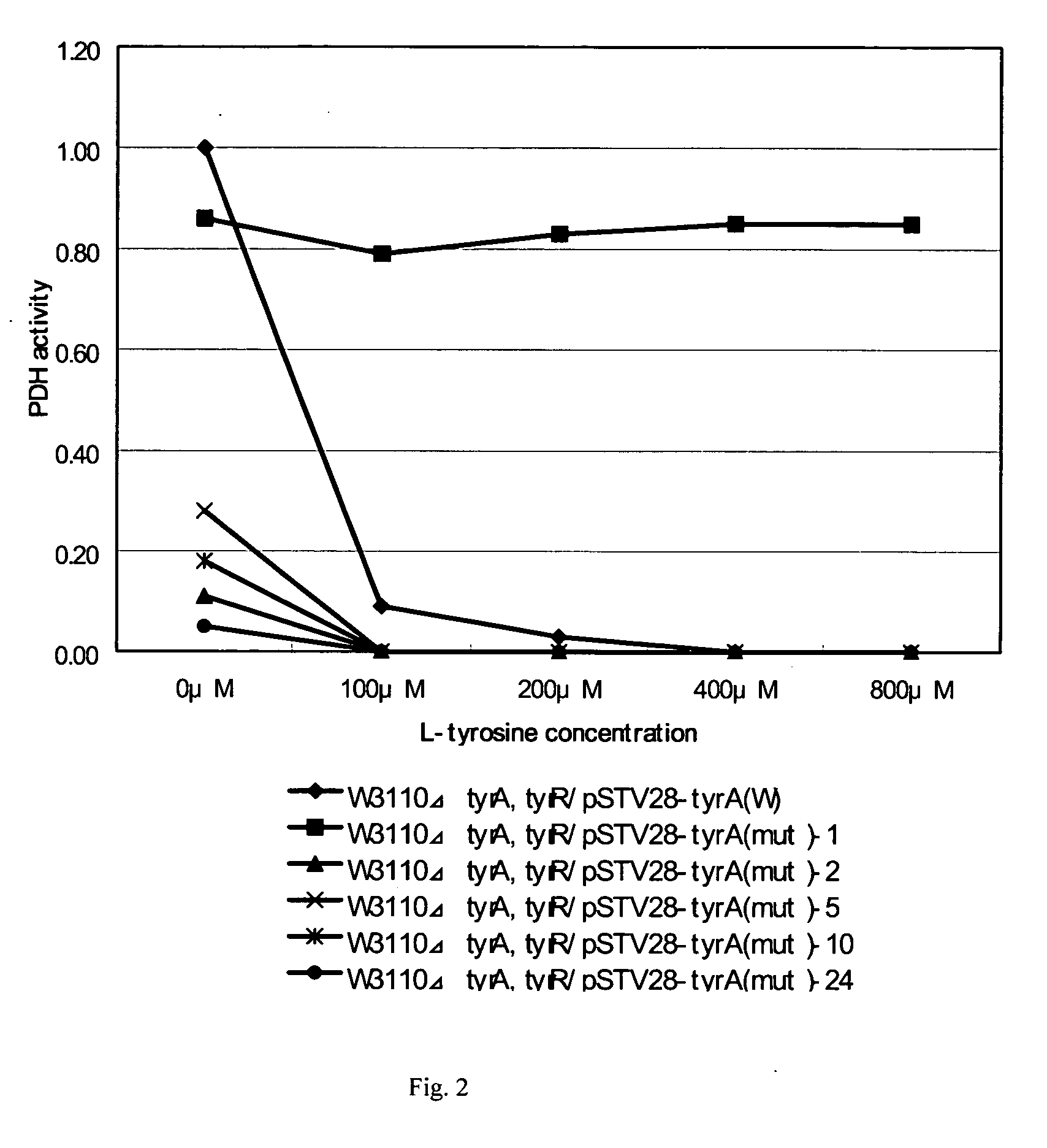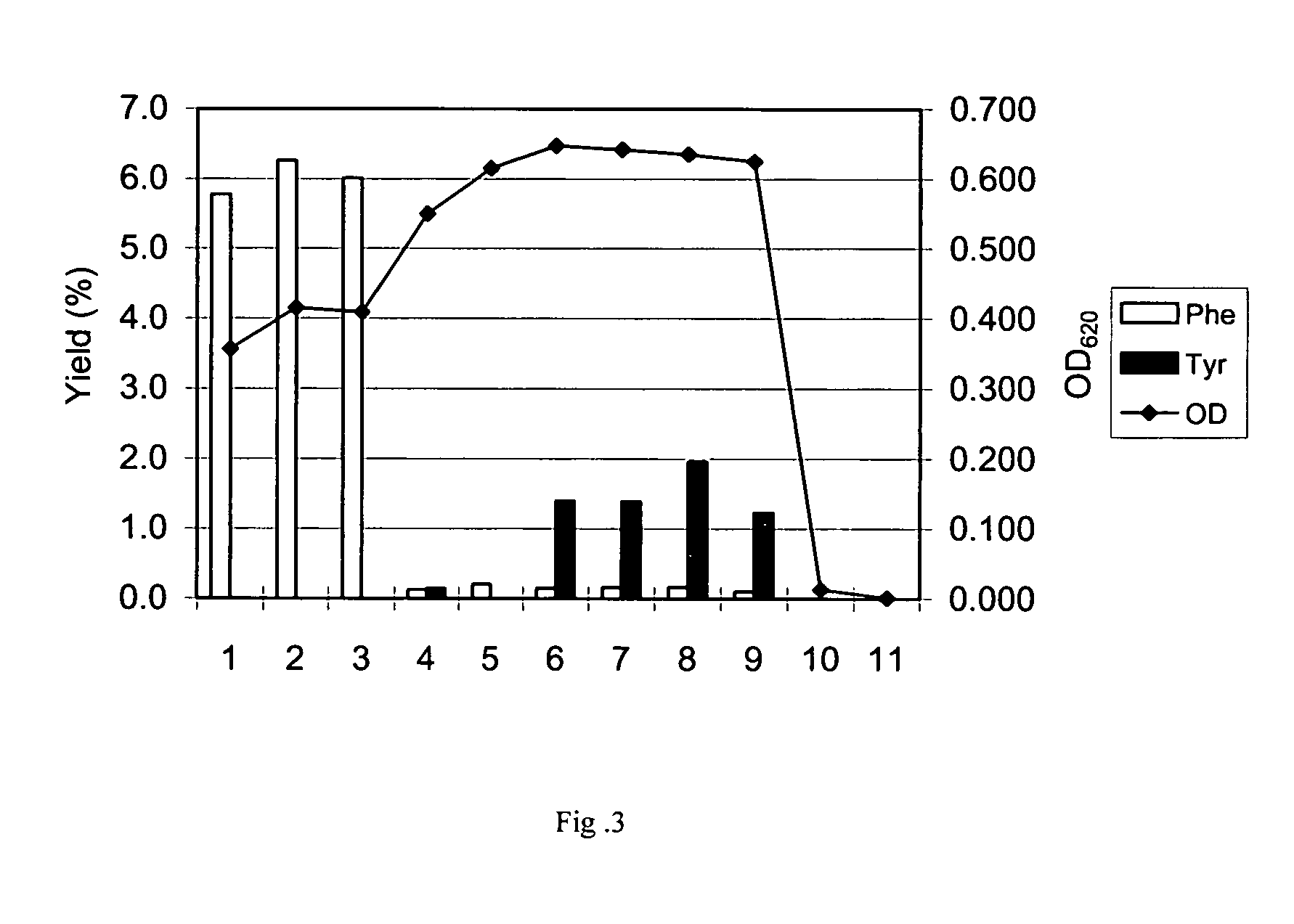L-tyrosine-producing bacterium and a method for producing L-tyrosine
a technology of ltyrosine and bacterium, which is applied in the direction of oxidoreductases, microorganisms, biochemical equipment and processes, etc., can solve the problems of low ltyrosine production efficiency of this bacterium, weak feedback inhibition, slow growth of this bacterium, etc., and achieves the effect of reducing the expression of a gene encoding a tyrosine repressor and reducing the expression
- Summary
- Abstract
- Description
- Claims
- Application Information
AI Technical Summary
Benefits of technology
Problems solved by technology
Method used
Image
Examples
example 1
[0118]
[0119] (1) Acquisition of a Mutant tyrA Gene Derived from Escherichia coli
[0120] Chromosomal DNA was extracted from an Escherichia coli K-12 W3110 strain according to a standard method. Two oligonucleotide primers having the nucleotide sequence shown in SEQ ID NO: 11 and 12 were synthesized, on the basis of the nucleotide sequence of wild-type tyrA gene described in J. Mol. Biol. 180(4), 1023 (1984). One of the primers has a nucleotide sequence corresponding to the region upstream of the ORF of the tyrA gene, and the other primer has a nucleotide sequence complementary to the region downstream of the ORF of the tyrA gene. Using the primers and the chromosomal DNA as a template, PCR was carried out to obtain an approximately 1-kbp DNA fragment containing the tyrA gene. As shown in FIG. 1, this fragment was digested with EcoRI and SalI and then ligated to pSTV28 (Takara Bio Inc.), and digested with EcoRI and SalI using a Ligation Kit Ver. 2 (Takara Bio Inc.). An Escherichia col...
example 2
[0130] Acquisition of Another Mutant tyrA Gene Encoding a Mutant PDH which is Desensitized to Feedback Inhibition>
[0131] (1) Acquisition of Mutant tyrA Gene Derived from Escherichia coli
[0132] Primers for randomly inserting mutations into amino acid positions 250 to 270 of the amino acid sequence of PDH (SEQ ID NO: 2) were designed (SEQ ID NOs: 15 to 35).
[0133] Those primers and the primers of SEQ ID NOs: 11 and 12 were used in PCR to introduce the mutations. The procedure is as follows (FIG. 8).
[0134] First PCR: any of the primers SEQ ID NOs: 15 to 35 and a T2 primer (SEQ ID NO: 12) are used to amplify a portion of the tyrA gene downstream from the mutation introduction site, from the template of pSTV tyrA(W) using pyrobest DNA polymerase (TAKARA).
[0135] Second PCR: A second PCR is carried out in the same reaction solution as that of the 1st PCR. That is, as shown in FIG. 8, the second PCR amplification proceeds after the generation of 1st PCR product. The PCR product amplified...
example 3
[0148]
[0149] Mutant tyrA genes were obtained similar to that described in Example 2 except that the 2nd PCR products obtained by each primer set were not mixed but separately used as a template for 3rd PCR. Three to ten clones of each transformant transformed with each of the 3rd PCR products were analyzed as a candidate for mutant tyrA-containing strains. The culture and nucleotide sequence analysis of those strains were carried out in Example 2 and the result is shown in Table 4. It was found that the mutations which cause amino acid substitutions in the region from amino acids positions 250 to 269 of PDH resulted in improved L-tyrosine yield.
TABLE 4Yield ofPositionoriginalmutationTyr (%)(1)250gcgAtttF1.10(2)251tttFagtS0.60(3)254gcaAtctS0.50(4)254gcaAccgP0.98(5)254gcaAcctP1.20(6)254gcaAggaG0.60(7)257cacHtacY5.50(8)257cacHactT3.00(9)257cacHtcaS2.10(10)257cacHgcgA3.00(11)258tttFtgtC0.58(12)258tttFgctA0.50(13)258tttFataI0.74(14)259gctAttaL1.40(15)259gctAgttV0.47(16)259gctAataI1.50(...
PUM
| Property | Measurement | Unit |
|---|---|---|
| pH | aaaaa | aaaaa |
| absorption wavelength | aaaaa | aaaaa |
| pH | aaaaa | aaaaa |
Abstract
Description
Claims
Application Information
 Login to View More
Login to View More - R&D
- Intellectual Property
- Life Sciences
- Materials
- Tech Scout
- Unparalleled Data Quality
- Higher Quality Content
- 60% Fewer Hallucinations
Browse by: Latest US Patents, China's latest patents, Technical Efficacy Thesaurus, Application Domain, Technology Topic, Popular Technical Reports.
© 2025 PatSnap. All rights reserved.Legal|Privacy policy|Modern Slavery Act Transparency Statement|Sitemap|About US| Contact US: help@patsnap.com



